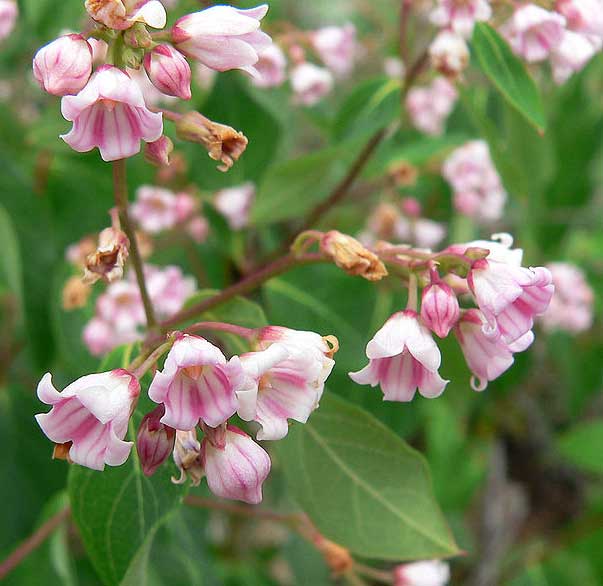
Apocynum androsaemifolium (*)
Classification System: APG IV
Superregnum: Eukaryota
Regnum: Plantae
Cladus: Angiosperms
Cladus: Eudicots
Cladus: Core eudicots
Cladus: Asterids
Cladus: Lamiids
Ordo: Gentianales
Familia: Apocynaceae
Subfamilia: Apocynoideae
Tribus: Apocyneae
Subtribus: Apocyinae
Genus: Apocynum
Species: Apocynum androsaemifolium
Subspecies: A. a. subsp. androsaemifolium – A. a. subsp. pumilum
Varietates: A. a. var. griseum – A. a. var. incanum – A. a. var. intermedium – A. a. var. tomentellum – A. a. var. woodsonii
Name
Apocynum androsaemifolium L., 1753
References
Linnaeus, C. 1753. Species Plantarum. Tomus I: 213. Reference page. "fol. androsaemi"
Links
Hassler, M. 2018. Apocynum androsaemifolium. World Plants: Synonymic Checklists of the Vascular Plants of the World In: Roskovh, Y., Abucay, L., Orrell, T., Nicolson, D., Bailly, N., Kirk, P., Bourgoin, T., DeWalt, R.E., Decock, W., De Wever, A., Nieukerken, E. van, Zarucchi, J. & Penev, L., eds. 2018. Species 2000 & ITIS Catalogue of Life. Published online. Accessed: 2018 Sep 17. Reference page.
International Plant Names Index. 2018. Apocynum androsaemifolium. Published online. Accessed: Sep 17 2018.
Govaerts, R. et al. 2018. Apocynum androsaemifolium in World Checklist of Selected Plant Families. The Board of Trustees of the Royal Botanic Gardens, Kew. Published online. Accessed: 2018 Sep 17. Reference page.
Tropicos.org 2018. Apocynum androsaemifolium. Missouri Botanical Garden. Published online. Accessed: 17 Sep 2018.
USDA, ARS, Germplasm Resources Information Network. Apocynum androsaemifolium in the Germplasm Resources Information Network (GRIN), U.S. Department of Agriculture Agricultural Research Service. Accessed: 09-Oct-10.
Vernacular names
English: Fly-trap dogbane
Apocynum androsaemifolium, the fly-trap dogbane or spreading dogbane, is a flowering plant in the Gentianales order.
The plant is common in North America, and is widespread across most of the United States and Canada, and in Alaska, California, and northeast Mexico.[1][2]
Contents
1 Description
1.1 Subspecies and varieties
2 Etymology
3 Toxicity
4 Uses
5 References
6 External links
Description
Apocynum androsaemifolium has branching stems, hairs on the underside of the leaves, and no hair on the stems.[3][4][5] Milky sap appears on broken stems.
Leaf margin is entire and leaf venation is alternate. Its leaves appear as pointed ovals, while its flowers appear terminally on a stalk.
The plant is poisonous[6] due to the cardiac glycosides and resins it contains.[7] Apocynum androsaemifolium is a perennial herb. Its native habitats include forests, woodlands, forest edges, prairies, meadows, and fields.[8]
Subspecies and varieties
Subspecies and varieties include:[1]
Apocynum androsaemifolium subsp. androsaemifolium - E Canada, W United States
Apocynum androsaemifolium var. griseum (Greene) Bég. & Belosersky - Ontario, British Columbia, Washington State, Oregon, Idaho, Indiana, Michigan
Apocynum androsaemifolium var. incanum A.DC. - widespread in Canada, United States, NE Mexico
Apocynum androsaemifolium var. intermedium Woodson - Colorado
Apocynum androsaemifolium subsp. pumilum (A.Gray) B.Boivin - British Columbia, Washington State, Oregon, Idaho, California, Utah, Montana, Wyoming, Nevada
Apocynum androsaemifolium var. tomentellum (Greene) B.Boivin - British Columbia, Washington State, Oregon, Idaho, California, Nevada
Apocynum androsaemifolium var. woodsonii B.Boivin - Alberta, British Columbia, Washington State, Wyoming, Nevada, Idaho
Etymology
Apocynum androsaemifolium Linnaeus. From the Greek “apo”: far from and “kyôn”: dog, because of its toxic effects on dogs; Androsema-leaved androsaemifolium ( Hypericum androsaemum ).
Toxicity
Escalating doses usually cause vomiting and diarrhea. Otherwise, the addict is dizzy, sees objects in green or yellow, excuses a cold sweat, and urinates a lot. His heart slows down and death follows after convultions. Before consuming the young milkweed shoots, it is essential to know how to distinguish them from those of the androsemus leaf beetle because they appear at the same time.
Uses
Native Americans used spreading dogbane in numerous ways. The plant was used as a medicine to treat ailments including headaches, convulsions, ear ache, heart palpitations, colds, insanity, dizziness, rheumatism, scrofula, and syphilis. The plant can also be used as a contraceptive.[9] Among the Ojibwe, the root was used as a gynecological, oral, and throat aid, as well as an analgesic for headaches and a diuretic during pregnancy. The Ojibwe also consumed the root of the plant during the medicine lodge ceremony.[10] The Forest Potawatomi made medicinal use of the roots as well, and the Prairie Potawatomi used the plant's fruits to treat heart and kidney problems.[9] The stem fibers of the plant are very strong,[10] and Native Americans used them as a thread for sewing.[11] Outside of the Americas, spreading dogbane was also used to treat heart disease in Europe during the first half of the twentieth century.[12]
References
"Apocynum androsaemifolium". World Checklist of Selected Plant Families (WCSP). Royal Botanic Gardens, Kew.
"Apocynum androsaemifolium". County-level distribution map from the North American Plant Atlas (NAPA). Biota of North America Program (BONAP). 2014.
Alan Hall, The Wild Food Guide, Holt, Rinehard, and Winston, 1976, pp. 171, 217
Blanchan, Neltje (2002). Wild Flowers: An Aid to Knowledge of our Wild Flowers and their Insect Visitors. Project Gutenberg Literary Archive Foundation.
Blanchan, Neltje (2005). Wild Flowers Worth Knowing. Project Gutenberg Literary Archive Foundation.
Whitney, Stephen (1985). Western Forests (The Audubon Society Nature Guides). New York: Knopf. pp. 589–90. ISBN 0-394-73127-1.
Elias, Thomas S.; Dykeman, Peter A. (2009) [1982]. Edible Wild Plants: A North American Field Guide to Over 200 Natural Foods. New York: Sterling. p. 267. ISBN 978-1-4027-6715-9. OCLC 244766414.
"Lady Bird Johnson Wildflower Center - The University of Texas at Austin". www.wildflower.org. Retrieved 2021-11-23.
"Apocynum androsaemifolium - Spreading Dogbane". flora.neocities.org. Retrieved 28 March 2021.
"BRIT - Native American Ethnobotany Database". Native American Ethnobotany DB. Retrieved 28 March 2021.
Fagan, Damian (2019). Wildflowers of Oregon: A Field Guide to Over 400 Wildflowers, Trees, and Shrubs of the Coast, Cascades, and High Desert. Guilford, CT: FalconGuides. p. 21. ISBN 978-1-4930-3633-2. OCLC 1073035766.
Xie, Wenyan; Zhang, Xiaoying; Wang, Tian; Hu, Jianjun (7 May 2012). "Botany, traditional uses, phytochemistry and pharmacology of Apocynum venetum L. (Luobuma): A review". Journal of Ethnopharmacology. 141 (1): 1–8. doi:10.1016/j.jep.2012.02.003. PMID 22421379. Retrieved 28 March 2021.
Retrieved from "http://en.wikipedia.org/"
All text is available under the terms of the GNU Free Documentation License

